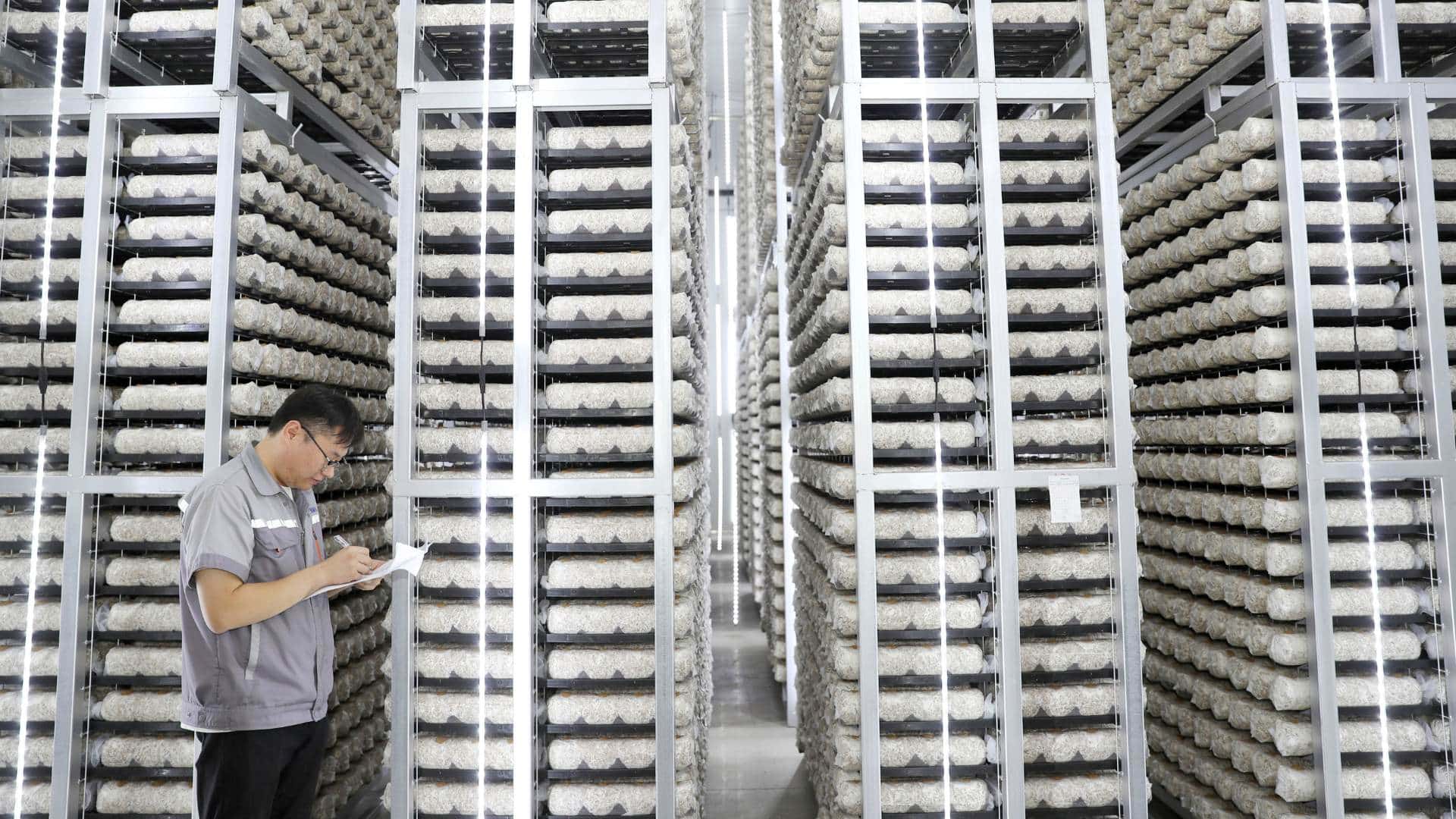It is the top trading partner for 120 countries. So if China’s economy tanks so will the world. But fears that that will happen may be overblown.

A worker checks the growth of mushroom at a modern agricultural company in Laixi city in east China’s Shandong province on 13 August 2023. (FeatureChina via AP Images)
This article was produced exclusively for News Decoder’s global news service. It is through articles like this that News Decoder strives to provide context to complex global events and issues and teach global awareness through the lens of journalism. Learn how you can incorporate our resources and services into your classroom or educational program.
The new year has started with a solid consensus: China’s economy is in big trouble. Heavily indebted, ageing fast and with its huge property sector slumping, China faces protracted stagnation, like Japan before it.
So goes the latest thinking. Yet it is far too soon to write China off.
To be sure, China’s boom years are behind it. That is no surprise. It would have been arithmetically impossible to maintain the annual growth rate of close to 10% chalked up between 1980 and 2010.
Beijing was targeting an expansion of around 5% last year, but some researchers reckon even that pace cannot be sustained. They suspect the country’s potential growth rate is now as low as 3.5%.
How the economy fares matters not just to China’s 1.4 billion people, many of whom still live near the poverty line, but to the rest of the world.
A slowing economy with strong growth
China is the second-largest economy after the United States and is the top trading partner for more than 120 countries. Soy growers in Latin America, commodity miners in Africa, machine builders in Germany, makers of handbags and gladrags in France and oil producers around the world all hang on China’s fortunes.
It’s important to put the slowdown in context. The International Monetary Fund still expects China to have generated more than a third of last year’s increase in global GDP. By expanding output at a 5% clip, China is creating an economy the size of Italy’s every three years. Size matters.
Misguided policy decisions have undoubtedly darkened the country’s economic outlook. China waited too long to deflate its property bubble. Investment remains too high and consumption too low, leaving growth just as unbalanced and unsustainable as then Premier Wen Jiabao declared it to be in 2007.
Nonetheless, it would be a mistake to give up on China.
Since he took power in 2012 President Xi Jinping has prioritised national security and ever-tighter political control, crushing the spirits of businesses and households in the process.
A GDP that still lags its economic rivals
Still Xi knows the Communist Party’s legitimacy will be at risk if it fails to deliver ever-rising living standards. That’s why officials have relaxed several policies that were stifling growth. High-tech titans such as Alibaba that were cut down to size after the Party judged them to be getting too powerful are slowly being rehabilitated. Rules to curb spending on online games have been walked back. Tough restrictions on the transfer of data overseas — deemed a threat to national security — have been eased a bit.
Looking farther ahead, there are two big fundamental reasons to be optimistic about China’s economic prospects.
First, there’s the potential for economic catch-up. In his News Decoder article last September asking whether China had already peaked, correspondent John West points out that this becomes harder as countries climb the development ladder; easy gains can be pocketed only once.
But, again, context is important. China’s GDP per capita in 1980 was just 2% of that in the United States. By 2022, after four decades of giddy growth, it was still only 28% of the United States. As Martin Wolf explained in the Financial Times: “This is just under four doublings. Is another doubling over, say, 20 years inconceivable?”
To help answer the question, Wolf draws a comparison with South Korea, which experienced a boom similar to China’s, but earlier. Starting at 9% of U.S. GDP per head in the early 1960s, South Korea reached China’s current mark of 28% by 1988. It now stands at 70%. And Taiwan has done even better, Wolf notes.
Recharging the economy with electric cars
Sceptics stress that China’s population has started to shrink, automatically reducing its growth potential. An obvious counter-measure would be to gradually raise the strikingly low retirement age of 60 for men and 55 or 50 for women. After all, life expectancy has risen from 51 in 1962 to 78 today.
And there is still plenty of room to revive flagging productivity growth by moving peasants to more-productive urban manufacturing and service jobs. Nearly a quarter of those employed in China work in agriculture, compared with 2% in the United States.
The second reason to be optimistic is China’s technological capacity. Already a leader in green energy, China is set to become the biggest car exporter in 2024 thanks to its dominance in electric vehicles (EVs), which in turn rests on the fact that it supplies over two-thirds of all car batteries. Chinese company BYD recently overtook Elon Musk’s Tesla to become the biggest-selling manufacturer of EVs.
Higher up the tech ladder, Huawei last year overcame U.S. sanctions on the transfer of chip-making technology to unveil a 5G smartphone powered by a sophisticated, domestically manufactured chip — an advance that Washington called deeply disturbing.
China turns out 1.4 million engineers a year. It is now pouring resources into quantum computing, cloud computing and artificial intelligence.
Deep pockets and domestic savings
Of course, China faces headwinds.
Its exports would suffer if Donald Trump were re-elected in November 2024 and carried out his threat to impose across-the-board tariffs. The staggering debts incurred by local governments and property companies will take the rest of the decade to work out.
But whereas the mortgage crisis in the United States in 2008 brought the banking system to its knees, China need not fear a financial collapse. It is a creditor country with a big current account surplus and a huge pool of domestic savings, meaning it is not dependent on inflows of foreign capital. The Party-state could, in theory, still mobilize vast resources to stabilise the economy if it needed to.
Holger Schmieding, chief economist of German investment bank Berenberg, said policymakers now realised the risks entailed by a rising pile of debt, so help for the economy this year would be limited and well targeted, as in 2023. “Although China continues to struggle with the legacy of past excesses, it can and most likely will inject enough stimulus to prevent a bigger calamity,” he said.
A year ago the market was convinced that the United States was headed for recession and that the Federal Reserve would cut interest rates. Wrong on both counts. Don’t be surprised if the bearish consensus about China in 2024 also turns out to be wrong.
Questions to consider:
-
- Are China’s best economic days behind it, or still to come?
- Should the United States relax its trade and investment sanctions against China?
- If China is peaking, which emerging markets might be the next big economic powers?

Alan Wheatley is an economics writer and editor based in London. Until recently, he was Reuters’s global economics correspondent, reporting from more than 40 countries and living in London, Frankfurt, Paris, New York, Washington, Tokyo, Singapore and Beijing. He is co-author of the book The Power of Currencies, Currencies of Power, which explores the consequences of looming challenges to the dollar’s status as the world’s leading reserve currency.
Read more News Decoder stories about China and its economy here:
